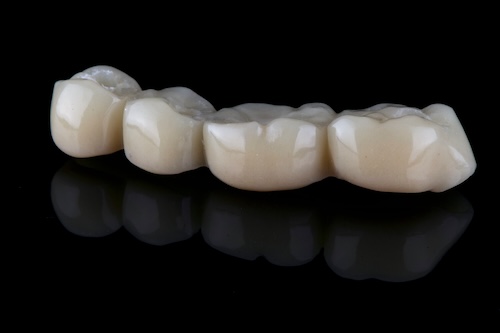What is a dental bridge?
A dental bridge is a solution for missing a tooth or multiple teeth. The teeth on either side of the space need to be reduced or filed down. So you have one end with a tooth, another end with a tooth, and together they're bridged.
How does a dental bridge differ from dentures?
Dental bridges are cemented into the mouth, meaning you cannot remove them, whereas a denture you can take in and out.
What are the pros and cons of dental bridges?
The pro of a dental bridge is that it's generally fast to get. We can do it on the same day. The con of dental bridges is that we have to cut the teeth down. You have to reduce the size of the surrounding teeth, otherwise, you cannot put a bridge over on top of it.
What are the different types of dental bridges?
There can be different materials used in dental bridges. The older ones contain metal, the newer ones are all ceramic. It can be your traditional fixed dental bridge that's cemented into the mouth or cemented onto the adjacent teeth, or it can be a Maryland bridge.
What are the alternatives to a dental bridge?
The best alternative to a dental bridge would be implants. The biggest advantage of implants is you're not having to cut the surrounding teeth.
Could you explain the difference between a removable dental bridge and a fixed dental bridge?
A removable dental bridge essentially would be dentures. A fixed dental bridge involves where we cut down the surrounding teeth and cement it in.
What is a cantilever dental bridge?
I'm not going to get into this because I don't do them.
What are the benefits of dental bridges?
The benefits of dental bridges are that you can get them faster than implants. As long as you have good bone on those surrounding teeth, you can get it either the same day or within a week or two.
How can a dental bridge help those with gum disease?
Dental bridges require maintenance. So someone with gum disease may not be a good candidate for dental bridges because you can trap food under them.
Is dental bridge work painful?
Dental bridge work is not painful. You will be numb before we cut down any of the surrounding teeth.
What does a dental bridge placement procedure involve?
Dental bridge placement involves a consultation, filing down the teeth, taking an impression and a bridge is made and cemented over on top of that.
How long does a dental bridge last?
A dental bridge can last many years with proper home care.
How should I care for my dental bridge?
You have to keep them clean. Oftentimes food gets stuck. A water pick is the best tool to use for cleaning.
When should I schedule an appointment for a dental bridge?
If you are missing teeth and are interested in a dental bridge or perhaps an implant, give us a call at (845) 358-5110.
Many individuals experience the common occurrence of missing one or more teeth.

According to the ADA, adults may typically have an average of three missing or decayed teeth. Thankfully, several solutions exist for replacing missing teeth, including dental bridges.
A dental bridge may serve to restore an area with one or more adjacent missing teeth. Comprising two primary components, a bridge consists of abutments (or supports) and a pontic, which is the synthetic tooth replacing the missing one. In cases of a single missing tooth, the adjacent teeth are prepared for crowns, with the synthetic tooth connected to these crowns. For multiple adjacent missing teeth, one or more implants may be utilized as abutments.
There are four main types of dental bridges:
- Traditional Dental Bridge: This common type involves crowning existing teeth with pontics held in place by the crowned abutments, creating a support structure or "bridge" for the missing teeth.
- Cantilever Bridge: Like a traditional bridge but supported on only one side, potentially causing additional stress on the supporting tooth.
- Implant-Supported Bridge: Instead of relying on existing teeth, dental implants provide support for one or both sides of the bridge, offering a secure restoration, especially beneficial for multiple adjacent missing teeth.
- Maryland Bridge: Supported by a metal structure cemented onto the back of existing teeth, this bridge preserves adjacent tooth structure by avoiding the use of crowns for abutments. However, it may not withstand heavy forces during biting and chewing and can exert pressure on supporting teeth.
Reach out to our office to explore your restorative options and achieve the smile you desire.

